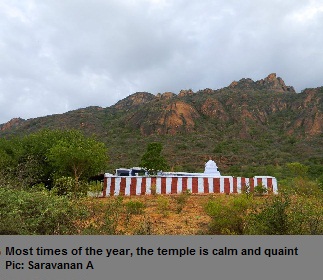Any and all opinions expressed in this newsletter are solely those of the author(s) and do not reflect the opinion of ATREE.
Centre for Excellence in Conservation Science
Royal Enclave,Srirampura,Jakkur Post
Bangalore-560064
Telephone: 080-23635555 (EPABX)
Fax : 080- 23530070
If you happen to drive on the narrow road
north of Kalakad you will notice a huge hill to
your left as your near the small town of
Kolundamamalai, a scrub clad hill jutting out
of the plains and separated from KMTR by a
deep and narrow irrigation canal. The legend
behind the origin of the hill has the usual
Hanuman story of dropping a part of the
Sanjivini mountain he was carrying from the
Himalayas to cure Lakshman of a near fatal
wound. The name Kolundamamalai is
supposed to come from 'kolundu' which
means fresh leaves. At the base of the hill,
approximately two km from the main road, is
a small old temple of Murugan which is
surrounded by scrub forest and plantations.
The temple rarely attracts visitors and once the evening sun dips behind the
Kolundamamalai hill, it remains a desolate
place in the tranquil darkness giving
company to sambars, civets and the
occasional owl.
If you do the same drive at dusk on the day of
the Thirukaarthigai or Kartik poornima which
falls in November or December, you will
notice a small fire (deepam) on top of the hill.
During this day the temple is decorated, well
lit, music is played and a temporary kitchen is
made to feed hundreds of people who come
to the temple. A small group of 3-4 people go
up the hill early in the day and reach the
summit in time to light the fire. The fire is lit in
2-3 places on the hill, some seen from the west and some from north west. This group
returns the next morning after making sure
the fire is properly doused. The hundreds of
people who visit the temple litter the place.
The forest department does its bit by putting
up bins to collect the garbage. Fortunately
nobody camps in the temple at night and the
temple returns to its desolate nature late at
night on the poornima day itself.
The Kolundamamalai temple is on the edge
of the forest and people do not venture inside
the scrub except for the small group that
lights the fire. The scrub is very dense in the
foothills and almost impenetrable. There is a
fair amount of wildlife around the temple;
sambar, porcupine, hare, bear, wild boar
apart from owls and number of birds of prey
that are found in the hills. There is also a small
group of langurs but they are confined to the
interiors. Our earlier mammal survey also
indicated presence of leopard and a tiger on
the western side of the hill. The presence of
the temple at the edge of the forest does not
currently have much impact on the forest
itself but to make sure that it does not become
a bigger pilgrimage in the near future, sincere
efforts will be required. It's still not in the list of
Murugan temples in Tamil Nadu which is a
blessing but that could be short lived as
newer temples are added to the list regularly.
To counter this it would be more pertinent to
encourage a greener festival with strict
regulations working with the temple authority,
forest department and other stakeholders
that would retain the sanctity and tranquillity
of the place.
Editorial Team
Editor: Allwin Jesudasan
Associate editor: Rajkamal Goswami
Editorial Review: R. Ganesan, M. Soubadra Devy, T. Ganesh
Design and presentation: Kiran Salegame
A S H O K A T R U S T F O R R E S E A R C H I N E C O L O G Y A N D T H E E
N V I R O N M E N T
Forest or temple on the edge?
- T Ganesh
If you have any suggestions or comments please let us know through the boxes below






